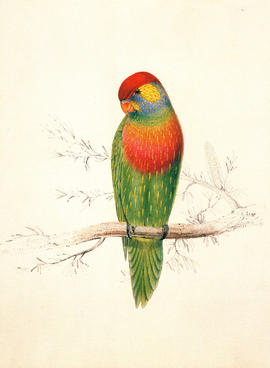The volume of prints from which this image is taken has been in the possession of the Society since it was first published. The Society is listed among the subscribers to the work, which would have been of particular relevance given its longstanding interest in printing (it regularly gave prizes for good examples of this craft). In a letter dated 13 March 1833, Lear wrote :'I have received from the Society a sheet of transferring lithographic paper, desiring my opinion of its suitableness for that purpose, and had I been at all accustomed to practice transferring, I should have felt very glad to have given it. As however I understand nothing of that part of the art of Lithography I have taken it to Mr Hullmandel.' Charles Hullmandel, the printer of 'Illustrations', received a silver medal from the Society in 1819 'for a lithographic drawing'. Lear was given permission to draw from life the parrots belonging to the Zoological Society of London. 18,000 copies sold.
Mr Davis's Chimney Brush was awarded the Society's Silver medal in 1806. In a letter dated 17 October 1806, B M Forster, who witnessed its original use and signed a certificate of approbation wrote :'I am convinced that chimnies may be swept as cleanly and effectually, as is commonly done with climbing-boys, so that the difference to the families who employ your machine will be, that they have the same comfort of a clean chimney, and are satisfied that they no longer use a method which is full of horrors and a disgrace to a civilised country'. The illustration of Joseph Davis's invention is taken from the Transaction of the Society, Vol XXV (1807). He received a number of other awards from the Society for his household inventions. Figures A are four brushes for sweeping the four sides of the chimney; figures B show two of the four springs which expand the machine to chimnies of all sizes; C represents the brush at the top of the machine proper for cleansing the pots; figures D show four lines to draw the brushes near together by a cord E, so that the machine may be forced up the chimney with greater facility. F shows the string to expand the brushes when the machine is at the top of the flue. 16,000 copies sold.
c
Part of a set of designs that was highly commended in the 1996 RSA Student Design Awards Scheme for the Postage Stamp brief:'It's Christmas'. The RSA Student Design Awards scheme celebrates the benefits that industry and education can bring to each other. Each year approximately 3000 students enter the scheme which is supported by commercial companies, trust funds, the European Commission and individuals. 15,000 copies sold
Illustration taken from 'Sketches Towards a Hortus Botanicus Americanus...of New and Valuable Plants of the West Indies and North and South America' by W J Titford MD Corresponding member of the Society of Arts, 1812. The Society encouraged the development of the Botanic Garden at St Vincent, where Captain William Bligh left some tropical fruits, including breadfruit for which he was awarded the Society gold medal in 1794.
Taken from a rare mezzotint from the Society's collection. At 20 years of age Lawrie received a bounty of 30 guineas in 1776 from the Society for 'disclosing his method of printing mezzotint in colour'. Lawrie copied the bird form one brought back by Captain Cook in the previous year at the conclusion of his second great voyage of discovery.
Mary Moser made this prize winning drawing when she was only 15. She subsequently became a founding member of the Royal Academy of Arts
Tim Clark was a pupil of the Government School of Design. Illustration from M Digby Wyatt, 'The Industrial Arts of the Nineteenth Century. A series of illustrations of the choicest specimens produced by every nation at the Great Exhibition, 1851' held in the Society's early library
Awarded the sum of twenty guineas by the Society for his set of working drawings in 1824
Landseer awarded the lesser silver palette for this drawing, done when he was 10 years old
Part of the 1998 RSA collection
Part of a pack of ten, all with slightly different designs. Developed from an original Christmas card design sold by the RSA in 1991
Limited edition of 200 copies
Includes correspondence and working papers
Includes arrangements for presentation by Prince Philip, on board the Royal Yacht Britannia and correspondence to and from Harold Macmillan
Includes details of arrangements for the presentation and reception at Windsor Castle by HRH Prince Philip.
Includes papers on the reception at the Library of Congress in Washington DC and the formation of the RSA's first American Chapter.
Includes speech notes, programme, guest list, seating plan, sample invitation and biographical information.
